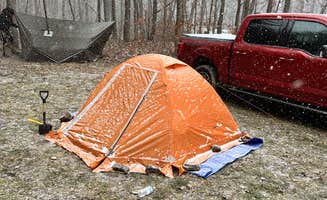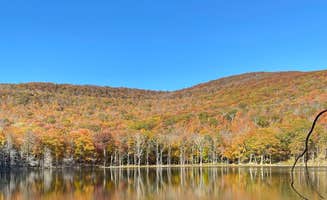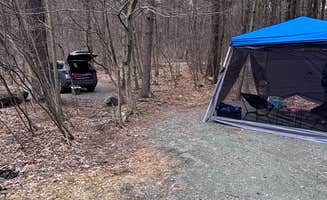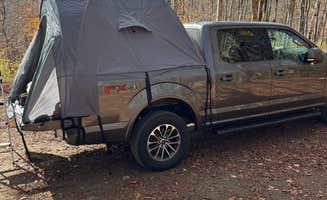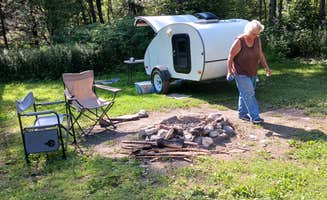Dispersed camping near Slingerlands, New York provides access to the northern edges of the Catskill Mountains and Helderberg Escarpment area. Most primitive campsites sit at elevations between 1,000-2,000 feet, creating cooler nighttime temperatures than Albany proper. Winter camping requires additional preparation as snowfall accumulations can reach 2-3 feet in higher elevations during January and February.
What to do
Fishing opportunities: Several dispersed camping areas offer access to streams and small bodies of water. At Echo Lake, "Lake is surrounded by hills and there is a small lean to with a few campfire spots. Other campsites are scattered and require navigating through small overgrown trails (wear pants)," according to James A. Bring a valid New York fishing license if planning to fish.
Mountain biking: NFR 273 Dispersed Camping Spot across the Vermont border offers terrain suitable for casual riders. "At least a dozen spots, some very spacious. Only crashed for 1 night but will be coming back to spend a few, this area was excellent!" reports Michele N. The surrounding forest roads provide multiple difficulty levels.
Wildlife viewing: The George D Aiken Wilderness Dispersed area supports varied wildlife habitats. "Great spot for quiet desolate camping. Several spots to choose from," notes Evan M. Early mornings offer the best wildlife spotting opportunities, particularly for deer and various bird species.
What campers like
Seasonal flexibility: Burnt Rossman State Forest - Westkill Camp offers year-round camping options. Felix R. shares: "Was a great location for winter camping. Site easily accessible from road. Beautiful, peaceful, great time!" The roadside location makes this site accessible even during colder months when other areas become difficult to reach.
Water proximity: Campers appreciate sites with stream access. Robert B. notes about Betty Brook Camp: "Love to camp here all year long have been coming to the area for a couple of decades now. Remote. Sometimes you never see anyone. Sometimes you see some people. You camp on the stream. There is a couple of spots." The sound of moving water adds to the camping experience.
Privacy levels: Many dispersed sites offer spacing between campers. At George D Aiken Wilderness, "The camp spots were all pretty spread out from each other and the road was easy to drive on. There were only about 10 spots along the access road," reports c H. This spacing creates a more isolated experience compared to developed campgrounds.
What you should know
Road conditions: Access roads to many sites require appropriate vehicles. Regarding Duck Pond Campsite, Yae U. advises: "Just be careful driving in the sometimes rough conditions." Seasonal weather can further degrade unpaved roads.
Bug preparation: Insect activity varies by location and season. At NFR 273, Natasha T. warns: "A LOT of bugs due to dense wooded surroundings. The bugs seems to be unbothered by the bug spray as well." Sites near standing water typically have higher mosquito activity, particularly after rainfall.
Campsite availability: Popular areas fill quickly during peak seasons. SJ W. reports about Vermont dispersed sites: "Went on a Wednesday night late October and had to drive about 4 miles down the dirt road to find a suitable spot. After what was very quiet and a peaceful place to be." Arriving mid-week or during shoulder seasons improves site selection.
Tips for camping with families
Lean-to options: Echo Lake provides shelter options for families. Kate notes: "There are tent sites around the whole lake with fire pits and 1 lean-to site at the end of the trail when you first arrive at the lake. The sites are relatively flat and well shaded with trees." The lean-to can provide backup shelter during unexpected weather.
Campfire planning: Established fire rings exist at most sites but not all. James A. shares about Echo Lake: "We camped on the hill with a beautiful view of the whole lake and breeze." Bringing a portable fire pan provides flexibility when established rings aren't available.
Water access planning: Few sites offer potable water. However, Fort Plain Lock 15 does provide this amenity: "At the lock parking area, you'll find pit toilets, a dumpster, and potable water available on the side of the building as you enter," reports Mona M. For other locations, plan to bring 1 gallon per person per day.
Tips from RVers
Size limitations: Most dispersed sites accommodate smaller recreational vehicles only. Peter from Betty Brook Camp advises: "I would not recommend this for large trailers. The site is fairly small, but it's in state park, and there's tons of walking that can be done." Class B and smaller Class C motorhomes typically fit better than larger rigs.
Parking considerations: Site entrances may present challenges after rain. The L. notes about Burnt Rossman State Forest: "Parking across the street if it's wet. Entrance is soft." Having leveling blocks and basic recovery equipment can prevent getting stuck in soft ground.
Overnight options: For those seeking easier access with RVs, Fort Plain Lock 15 offers flat parking. The L. describes it as: "Simply it's a parking lot with a view. The parking area is right on the water. It offers sounds of the highway and freight trains going by, my wife and I love it." This provides a convenient overnight option when traveling between destinations.


